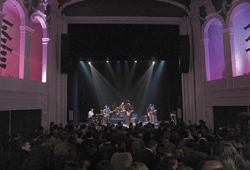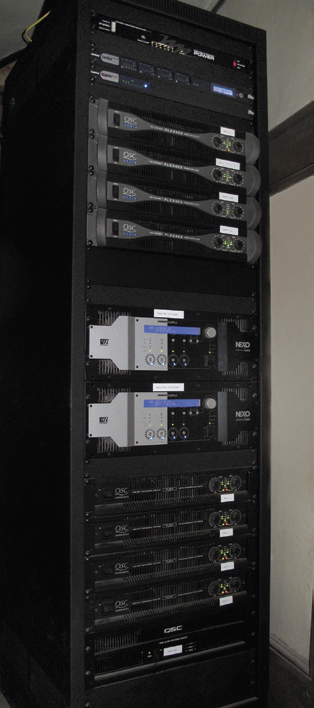
Bolstering the low-end are four EAW SB528z direct-radiating dual-18 subwoofers housed in chambers located equidistantly beneath the front of the stage, powered by four bridged QSC PowerLight PL224 amplifiers.
The size of the chambers, was quite limited due to existing infrastructure that couldn’t be moved, necessitating subs capable of providing commensurate performance from a compact package.
Combating Non-Linearity
The ample area extending under the first balcony, home to the main bar and plenty of space for patrons, was another primary focus of the design.
“What we’ve seen in the past with spaces of this nature, and what proved out here, is that these regions can suffer from a tremendous amount of mid-frequency buildup – really, more than anyone with ears should be able to tolerate,” Henion says.
“You can see it in any modeling program you choose to use – there’s a lot of non-linearity going on, particularly in the 300 to 800 Hz range.
Further, this zone opens to the front of the room through a narrow aperture which does not allow the main arrays to cover the space optimally at frequencies above 1,200 Hz or so”
The solution: First, optimize the splay of the main arrays for coverage above and below the two problem areas, those being the main balcony face and the opening into the under-balcony problem zone, steering as much HF away from those as possible.

Next, incorporate as much treatment as possible into the problem zone to “sock it down,” trying to neutralize the intrinsic sonic signature of the space.
SonoKrete was used to treat the entire ceiling in this zone, and the architect also worked some decorative heavy drape into the design.
Treating the ceiling this completely allowed Stage Sound to use a high-density array of quality loudspeakers on three tiers of delay (11 QSC AD S82-H compact 2-way models mounted horizontally) to provide direct coverage, without the typical ceiling reflections that often plague surface-mounted solutions.
“This approach not only serves this zone well, but it also smoothes out the entire room so that coverage to the main floor and first balcony is absolutely beautiful,” Henion states. “A nice thing about the NEXO arrays is that they allow adjustment of the splay over quite a range and still stay musical.
“The midrange still carries through that underbalcony area to some extent – there’s just not an absolute way to control it,” he continues, “but by steering the high end away and replacing it with that of the delays, it sounds really great. Even better than we hoped.”
In addition to the NEXO-specific DSP in the NEXAMPS, overall house system processing is supplied by a BSS Soundweb London BLU-160 DSP and a companion BSS BLU-BOB2 (breakout box) system expander.
It also facilitates eight modes of system operation, both in analog and digital, with one of the modes being a handy way for the bartender to provide background music from a bar-mounted iPod via a simple rotary switch located at the house mix position.
This also allows the house engineer to take control and fade or start the house music when appropriate.
